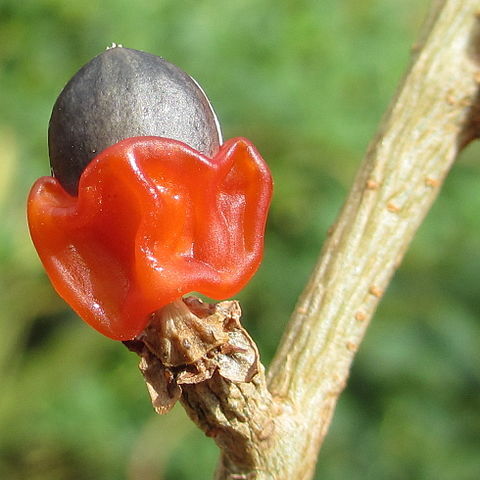Dioecious tree, often many-stemmed and up to 7 m tall; bark grey, not peeling; young branchlets shallowly fluted, glabrous. Leaves pinnate, 3-5-jugate, glabrous, green; petiole 15-60 mm long; leaflets oblanceolate to narrowly elliptic; petiolules 2-5 mm long; margins entire to finely serrate, apex obtuse to acute, base cuneate to rounded, terminal leaflet up to 70 x 35 mm, lateral leaflets up to 70 x 25 mm. Inflorescence: axillary, paniculate, simple or compound dichasial cymes. Flowers unisexual, perigynous. Pedicel 40-60 mm long, pedicel and calyx glabrous. Disc 4-lobed, adnate to hypanthium. Stamens 8. Fruit subglobose, ±18 x 15 x 15 mm, glabrous; putamen smooth; pseudo-aril red, cupular, covering lower third to half of putamen.
A shrub or tree. It grows up to 12 m high. The leaves have 3-4 pairs of leaflets and one at the end. The leaflets are 9.5 cm long by 3 cm wide. The flowers are small and creamy-green. They are in large loose heads. These can be 25 cm long. The fruit are large. They are 1.6 cm long by 0.9 cm wide. They hang downwards. They are brownish-red when mature. The stone has a fleshy, cup shaped false seed layer.
Leaves pinnate; petiole up to 13 cm. long, glabrous; leaflets 3–4-jugate, up to 9·5 × 3 cm., oblong-lanceolate, apex acute or acuminate, margin entire or undulate or very sparsely denticulate, base rounded or broadly cuneate, glabrous; petiolules up to 8 mm. long, but usually less, often with a few hairs near the point of attachment to the rhachis.
Fruit c. 1·6 × 0·9 cm., ellipsoid, apiculate, glabrous; pseudaril cupular, very fleshy, clasping the lowest third of the endocarp, margin undulate; endocarp c. 1 × 0·8 cm., ellipsoid, smooth, both faces moderately convex.
Tree, up to 7 m high. Bark grey, not peeling. Leaves pinnate, 3-5-jugate, glabrous, green; leaflets oblanceolate to narrowly elliptic, margin entire, terminal leaflet up to 70 x 35 mm. Flowers yellowish green.
Flowers appearing with the leaves, in axillary paniculate cymes up to 25 cm. long; branches of inflorescence glabrous; bracteoles up to 1 mm. long, ovate; pedicels 1–3 mm. long, slender, glabrous.
Tree up to 12 m. tall; bark smooth, grey, peeling with straw-coloured strips; young branches glabrous.
Calyx c. 2·5 mm. long, campanulate, tapering to the pedicel, lobed to half-way, glabrous.
Stamen-filaments somewhat broadened towards the base, disk-lobes not developed.
Petals c. 4 mm. long.


